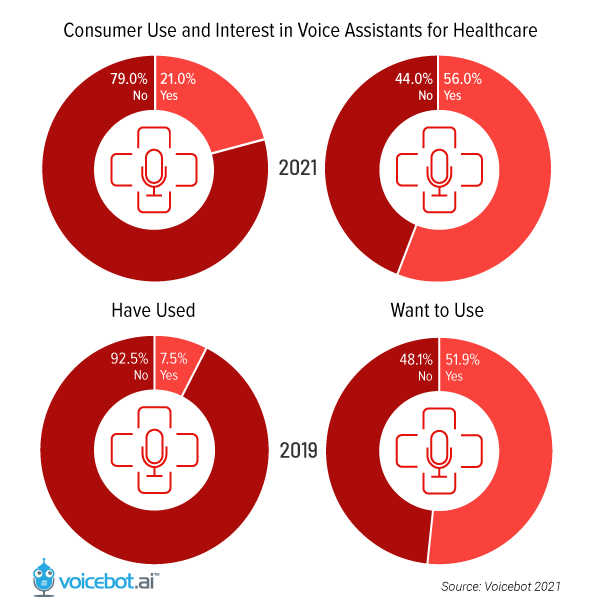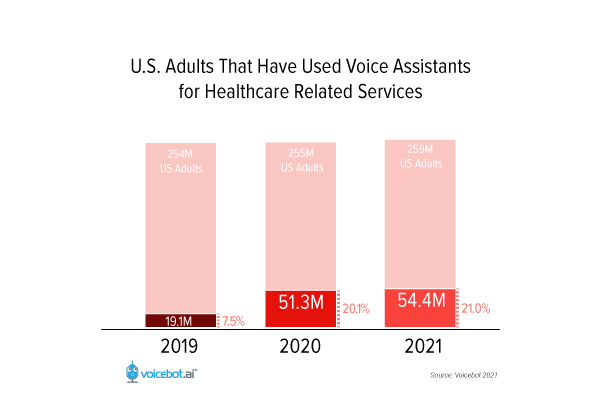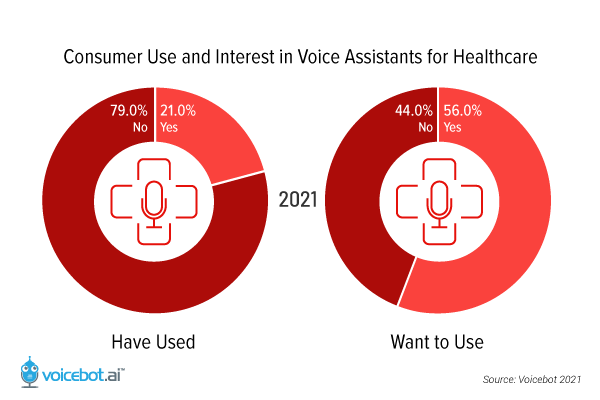Voice Assistant Use in Healthcare Nearly Tripled Over Two Years and Demand Still Outstrips Supply – New Report
Consumer interactions with healthcare have changed dramatically since the onset of the COVID-19 pandemic. One of those shifts has been a surge in the use of voice assistants and other conversational AI technologies in healthcare. In 2019, Voicebot found that just 7.5% of U.S. adults had used a voice assistant for a healthcare need. That figure vaulted to 21.0% in 2021.

Interest in using voice assistants for healthcare services was already high in 2019 with over 50% of consumers expressing interest. That interest climbed marginally to 56% in 2021 and shows that demand for voice assistant-enabled services still significantly outstrips the availability offered by healthcare providers. The rise in usage over the past two years appears to be driven by consumer interest in accessing information about illness (including COVID-19) and a greater supply of voice-enabled features by healthcare organizations.
The data comes from Voicebot’s Healthcare Voice Assistant Consumer Adoption Report 2022. Released today, the report includes 22 charts, over 30 pages of analysis, and additional resources. Voicebot shares data from 2019, 2020, and 2021 as well as an analysis of voice technology trends from the past two years. In addition to covering some similar questions posed to consumers in 2019, this report also captured sentiment related to chatbot and IVR use in healthcare to provide a broader view of conversational AI use in the industry.
Download ReportA Large New Market
Voice assistants had been used for healthcare use cases by just under 20 million U.S. adults as of mid-2019. The user base increased dramatically in 2020 as consumers were looking for information related to COVID-19 and other illnesses as access to medical care became limited. In addition, healthcare providers rolled out a series of new voice assistant and conversational AI solutions that arrived in a market with ready users. The user base climbed further in 2021 to 54.4 million.

What About the Enterprise?
The survey data in the Healthcare Voice Assistant Consumer Adoption Report focuses on consumer-facing applications. However, the report also tackles enterprise healthcare applications. The report includes a section on voice and conversational AI trends which lays out a model for segmenting the space into clinical and patient services. Under the clinical services section, there is a review of everything from automated data capture and diagnoses to chatbots for customer service.
Data in the Healthcare Voice Assistant Report
The Healthcare Voice Assistant Consumer Adoption Report 2022 is the most comprehensive analysis of the use, interest, and sentiment related to conversational AI technologies in the U.S. published to date. Among the 22 charts are included:
- U.S. Consumer Use and Interest in Voice Assistants for Healthcare 2019, 2021
- U.S. Adults That Have Used Voice Assistants for Healthcare Related Services 2019-21
- Voice AI in the Healthcare Technology Adoption Lifcycle
- Consumer Experience with 12 Healthcare Use Cases on Voice Assistants
- Devices Consumers Want to Use with Healthcare Voice Assistants 2019-21
- Voice Assistant Adoption on Smartphones 2021
- Household Income and General Purpose Voice Assistant Users for Healthcare
- Consumer Perception of Healthcare Providers with Chabots
- Consumer View of IVR Systems
- And, many more….(click to see the full chart list)
Use the button above to access the report. Also, if you have any questions feel free to message Bret Kinsella on Twitter. Happy New Year!
Follow @bretkinsella Follow @voicebotai
UK Smart Speaker Adoption Surpasses U.S. in 2020 – New Report with 33 Charts









